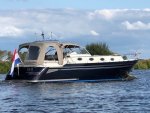texanaust
New member
We are looking into purchasing a motor cruiser that is comfortable in the Mediterranean Sea but can also navigate the canal systems of France, Netherlands, etc. We don't need access to the entire canal system if it would compromise on space and Med capabilities, but would like to explore. Two engines are a must, preferably between 40-50ft. Can any of the Fairline, Sealine, Princess flybridge cruisers fit under the bridges? Can owners modify the radar arches of these vessels to accommodate the inland waterways? What models do you recommend?
We are coming from Australia, so although we have boating experience, our knowledge of the canal systems and what is or is not possible is very limited. Thank you in advance
We are coming from Australia, so although we have boating experience, our knowledge of the canal systems and what is or is not possible is very limited. Thank you in advance

